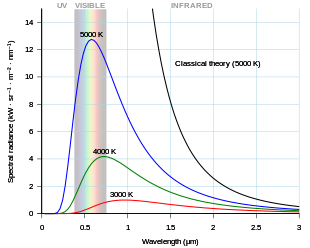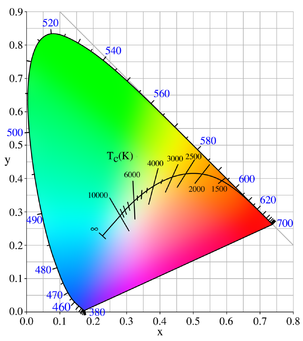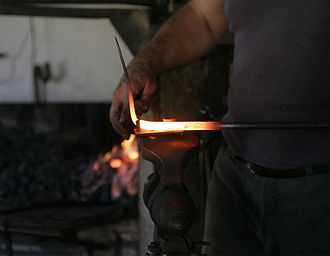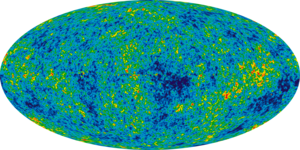
A | B | C | D | E | F | G | H | CH | I | J | K | L | M | N | O | P | Q | R | S | T | U | V | W | X | Y | Z | 0 | 1 | 2 | 3 | 4 | 5 | 6 | 7 | 8 | 9
This article's lead section may be too long. (January 2024) |
Black-body radiation is the thermal electromagnetic radiation within, or surrounding, a body in thermodynamic equilibrium with its environment, emitted by a black body (an idealized opaque, non-reflective body). It has a specific, continuous spectrum of wavelengths, inversely related to intensity, that depend only on the body's temperature, which is assumed, for the sake of calculations and theory, to be uniform and constant.[1][2][3][4]

A perfectly insulated enclosure which is in thermal equilibrium internally contains blackbody radiation, and will emit it through a hole made in its wall, provided the hole is small enough to have a negligible effect upon the equilibrium. The thermal radiation spontaneously emitted by many ordinary objects can be approximated as blackbody radiation.
Of particular importance, although planets and stars (including the Earth and Sun) are neither in thermal equilibrium with their surroundings nor perfect black bodies, blackbody radiation is still a good first approximation for the energy they emit. The Sun's radiation, after being filtered by the Earth's atmosphere, thus characterises "daylight", which humans (also most other animals) have evolved to use for vision.[5]
A black body at room temperature (23 °C (296 K; 73 °F)) radiates mostly in the infrared spectrum, which cannot be perceived by the human eye,[6] but can be sensed by some reptiles. As the object increases in temperature to about 500 °C (773 K; 932 °F), the emission spectrum gets stronger and extends into the human visual range, and the object appears dull red. As its temperature increases further, it emits more and more orange, yellow, green, and blue light (and ultimately beyond violet, ultraviolet).
Tungsten filament lights have a continuous black body spectrum with a cooler colour temperature, around 2,700 K (2,430 °C; 4,400 °F), which also emits considerable energy in the infrared range. Modern-day fluorescent and LED lights, which are more efficient, do not have a continuous black body emission spectrum, rather emitting directly, or using combinations of phosphors that emit multiple narrow spectrums.

Black holes are near-perfect black bodies in the sense that they absorb all the radiation that falls on them. It has been proposed that they emit blackbody radiation (called Hawking radiation) with a temperature that depends on the mass of the black hole.[7]
The term black body was introduced by Gustav Kirchhoff in 1860.[8] Blackbody radiation is also called thermal radiation, cavity radiation, complete radiation or temperature radiation.
Theory
Spectrum


Black-body radiation has a characteristic, continuous frequency spectrum that depends only on the body's temperature,[10] called the Planck spectrum or Planck's law. The spectrum is peaked at a characteristic frequency that shifts to higher frequencies with increasing temperature, and at room temperature most of the emission is in the infrared region of the electromagnetic spectrum.[11][12][13] As the temperature increases past about 500 degrees Celsius, black bodies start to emit significant amounts of visible light. Viewed in the dark by the human eye, the first faint glow appears as a "ghostly" grey (the visible light is actually red, but low intensity light activates only the eye's grey-level sensors). With rising temperature, the glow becomes visible even when there is some background surrounding light: first as a dull red, then yellow, and eventually a "dazzling bluish-white" as the temperature rises.[14][15] When the body appears white, it is emitting a substantial fraction of its energy as ultraviolet radiation. The Sun, with an effective temperature of approximately 5800 K,[16] is an approximate black body with an emission spectrum peaked in the central, yellow-green part of the visible spectrum, but with significant power in the ultraviolet as well.
Blackbody radiation provides insight into the thermodynamic equilibrium state of cavity radiation.
Black body
All normal (baryonic) matter emits electromagnetic radiation when it has a temperature above absolute zero. The radiation represents a conversion of a body's internal energy into electromagnetic energy, and is therefore called thermal radiation. It is a spontaneous process of radiative distribution of entropy.

Conversely, all normal matter absorbs electromagnetic radiation to some degree. An object that absorbs all radiation falling on it, at all wavelengths, is called a black body. When a black body is at a uniform temperature, its emission has a characteristic frequency distribution that depends on the temperature. Its emission is called blackbody radiation.
The concept of the black body is an idealization, as perfect black bodies do not exist in nature.[17] However, graphite and lamp black, with emissivities greater than 0.95, are good approximations to a black material. Experimentally, blackbody radiation may be established best as the ultimately stable steady state equilibrium radiation in a cavity in a rigid body, at a uniform temperature, that is entirely opaque and is only partly reflective.[17] A closed box with walls of graphite at a constant temperature with a small hole on one side produces a good approximation to ideal blackbody radiation emanating from the opening.[18][19]
Blackbody radiation has the unique absolutely stable distribution of radiative intensity that can persist in thermodynamic equilibrium in a cavity.[17] In equilibrium, for each frequency, the intensity of radiation which is emitted and reflected from a body relative to other frequencies (that is, the net amount of radiation leaving its surface, called the spectral radiance) is determined solely by the equilibrium temperature and does not depend upon the shape, material or structure of the body.[20] For a black body (a perfect absorber) there is no reflected radiation, and so the spectral radiance is entirely due to emission. In addition, a black body is a diffuse emitter (its emission is independent of direction). Consequently, blackbody radiation may be viewed as the radiation from a black body at thermal equilibrium.
Blackbody radiation becomes a visible glow of light if the temperature of the object is high enough.[21] The Draper point is the temperature at which all solids glow a dim red, about 798 K.[22] At 1000 K, a small opening in the wall of a large uniformly heated opaque-walled cavity (such as an oven), viewed from outside, looks red; at 6000 K, it looks white. No matter how the oven is constructed, or of what material, as long as it is built so that almost all light entering is absorbed by its walls, it will contain a good approximation to blackbody radiation. The spectrum, and therefore color, of the light that comes out will be a function of the cavity temperature alone. A graph of the spectral radiation intensity plotted versus frequency(or wavelength) is called the blackbody curve. Different curves are obtained by varying the temperature.

Two bodies that are at the same temperature stay in mutual thermal equilibrium, so a body at temperature T surrounded by a cloud of light at temperature T on average will emit as much light into the cloud as it absorbs, following Prevost's exchange principle, which refers to radiative equilibrium. The principle of detailed balance says that in thermodynamic equilibrium every elementary process works equally in its forward and backward sense.[23][24] Prevost also showed that the emission from a body is logically determined solely by its own internal state. The causal effect of thermodynamic absorption on thermodynamic (spontaneous) emission is not direct, but is only indirect as it affects the internal state of the body. This means that at thermodynamic equilibrium the amount of every wavelength in every direction of thermal radiation emitted by a body at temperature T, black or not, is equal to the corresponding amount that the body absorbs because it is surrounded by light at temperature T.[25]
When the body is black, the absorption is obvious: the amount of light absorbed is all the light that hits the surface. For a black body much bigger than the wavelength, the light energy absorbed at any wavelength λ per unit time is strictly proportional to the blackbody curve. This means that the blackbody curve is the amount of light energy emitted by a black body, which justifies the name. This is the condition for the applicability of Kirchhoff's law of thermal radiation: the blackbody curve is characteristic of thermal light, which depends only on the temperature of the walls of the cavity, provided that the walls of the cavity are completely opaque and are not very reflective, and that the cavity is in thermodynamic equilibrium.[26] When the black body is small, so that its size is comparable to the wavelength of light, the absorption is modified, because a small object is not an efficient absorber of light of long wavelength, but the principle of strict equality of emission and absorption is always upheld in a condition of thermodynamic equilibrium.
In the laboratory, blackbody radiation is approximated by the radiation from a small hole in a large cavity, a hohlraum, in an entirely opaque body that is only partly reflective, that is maintained at a constant temperature. (This technique leads to the alternative term cavity radiation.) Any light entering the hole would have to reflect off the walls of the cavity multiple times before it escaped, in which process it is nearly certain to be absorbed. Absorption occurs regardless of the wavelength of the radiation entering (as long as it is small compared to the hole). The hole, then, is a close approximation of a theoretical black body and, if the cavity is heated, the spectrum of the hole's radiation (that is, the amount of light emitted from the hole at each wavelength) will be continuous, and will depend only on the temperature and the fact that the walls are opaque and at least partly absorptive, but not on the particular material of which they are built nor on the material in the cavity (compare with emission spectrum).
The radiance or observed intensity is not a function of direction. Therefore, a black body is a perfect Lambertian radiator.
Real objects never behave as full-ideal black bodies, and instead the emitted radiation at a given frequency is a fraction of what the ideal emission would be. The emissivity of a material specifies how well a real body radiates energy as compared with a black body. This emissivity depends on factors such as temperature, emission angle, and wavelength. However, it is typical in engineering to assume that a surface's spectral emissivity and absorptivity do not depend on wavelength so that the emissivity is a constant. This is known as the gray body assumption.

With non-black surfaces, the deviations from ideal blackbody behavior are determined by both the surface structure, such as roughness or granularity, and the chemical composition. On a "per wavelength" basis, real objects in states of local thermodynamic equilibrium still follow Kirchhoff's Law: emissivity equals absorptivity, so that an object that does not absorb all incident light will also emit less radiation than an ideal black body; the incomplete absorption can be due to some of the incident light being transmitted through the body or to some of it being reflected at the surface of the body.
In astronomy, objects such as stars are frequently regarded as black bodies, though this is often a poor approximation. An almost perfect blackbody spectrum is exhibited by the cosmic microwave background radiation. Hawking radiation is the hypothetical blackbody radiation emitted by black holes, at a temperature that depends on the mass, charge, and spin of the hole. If this prediction is correct, black holes will very gradually shrink and evaporate over time as they lose mass by the emission of photons and other particles.
A black body radiates energy at all frequencies, but its intensity rapidly tends to zero at high frequencies (short wavelengths). For example, a black body at room temperature (300 K) with one square meter of surface area will emit a photon in the visible range (390–750 nm) at an average rate of one photon every 41 seconds, meaning that, for most practical purposes, such a black body does not emit in the visible range.[29]
The study of the laws of black bodies and the failure of classical physics to describe them helped establish the foundations of quantum mechanics.
Further explanation
According to the Classical Theory of Radiation, if each Fourier mode of the equilibrium radiation (in an otherwise empty cavity with perfectly reflective walls) is considered as a degree of freedom capable of exchanging energy, then, according to the equipartition theorem of classical physics, there would be an equal amount of energy in each mode. Since there are an infinite number of modes, this would imply infinite heat capacity, as well as a nonphysical spectrum of emitted radiation that grows without bound with increasing frequency, a problem known as the ultraviolet catastrophe.
In the longer wavelengths this deviation is not so noticeable, as and are very small. In the shorter wavelengths of the ultraviolet range, however, classical theory predicts the energy emitted tends to infinity, hence the ultraviolet catastrophe. The theory even predicted that all bodies would emit most of their energy in the ultraviolet range, clearly contradicted by the experimental data which showed a different peak wavelength at different temperatures (see also Wien's law).

Instead, in the quantum treatment of this problem, the numbers of the energy modes are quantized, attenuating the spectrum at high frequency in agreement with experimental observation and resolving the catastrophe. The modes that had more energy than the thermal energy of the substance itself were not considered, and because of quantization modes having infinitesimally little energy were excluded.
Thus for shorter wavelengths very few modes (having energy more than ) were allowed, supporting the data that the energy emitted is reduced for wavelengths less than the wavelength of the observed peak of emission.
Notice that there are two factors responsible for the shape of the graph, which can be seen as working opposite to one another. Firstly, shorter wavelengths have a larger number of modes associated with them. This accounts for the increase in spectral radiance as one moves from the longest wavelengths towards the peak at relatively shorter wavelengths. Secondly, though, at shorter wavelengths more energy is needed to reach the threshold level to occupy each mode: the more energy needed to excite the mode, the lower the probability that this mode will be occupied. As the wavelength decreases, the probability of exciting the mode becomes exceedingly small, leading to fewer of these modes being occupied: this accounts for the decrease in spectral radiance at very short wavelengths, left of the peak. Combined, they give the characteristic graph.[30]
Calculating the blackbody curve was a major challenge in theoretical physics during the late nineteenth century. The problem was solved in 1901 by Max Planck in the formalism now known as Planck's law of blackbody radiation.[31] By making changes to Wien's radiation law (not to be confused with Wien's displacement law) consistent with thermodynamics and electromagnetism, he found a mathematical expression fitting the experimental data satisfactorily. Planck had to assume that the energy of the oscillators in the cavity was quantized, which is to say that it existed in integer multiples of some quantity. Einstein built on this idea and proposed the quantization of electromagnetic radiation itself in 1905 to explain the photoelectric effect. These theoretical advances eventually resulted in the superseding of classical electromagnetism by quantum electrodynamics. These quanta were called photons and the blackbody cavity was thought of as containing a gas of photons. In addition, it led to the development of quantum probability distributions, called Fermi–Dirac statistics and Bose–Einstein statistics, each applicable to a different class of particles, fermions and bosons.
The wavelength at which the radiation is strongest is given by Wien's displacement law, and the overall power emitted per unit area is given by the Stefan–Boltzmann law. So, as temperature increases, the glow color changes from red to yellow to white to blue. Even as the peak wavelength moves into the ultra-violet, enough radiation continues to be emitted in the blue wavelengths that the body will continue to appear blue. It will never become invisible—indeed, the radiation of visible light increases monotonically with temperature.[32] The Stefan–Boltzmann law also says that the total radiant heat energy emitted from a surface is proportional to the fourth power of its absolute temperature. The law was formulated by Josef Stefan in 1879 and later derived by Ludwig Boltzmann. The formula E = σT4 is given, where E is the radiant heat emitted from a unit of area per unit time, T is the absolute temperature, and σ = 5.670367×10−8 W·m−2⋅K−4 is the Stefan–Boltzmann constant.[33]
Equations
Planck's law of blackbody radiation
Planck's law states that[34]
- is the spectral radiance (the power per unit solid angle and per unit of area normal to the propagation) density of frequency radiation per unit frequency at thermal equilibrium at temperature . Units: power / .
- is the Planck constant;
- is the speed of light in vacuum;
- is the Boltzmann constant;
- is the frequency of the electromagnetic radiation;
- is the absolute temperature of the body.
For a black body surface, the spectral radiance density (defined per unit of area normal to the propagation) is independent of the angle of emission with respect to the normal. However, this means that, following Lambert's cosine law, is the radiance density per unit area of emitting surface as the surface area involved in generating the radiance is increased by a factor with respect to an area normal to the propagation direction. At oblique angles, the solid angle spans involved do get smaller, resulting in lower aggregate intensities.
The emitted energy flux density or irradiance , is related to the photon flux density through[35]
Wien's displacement law
Wien's displacement law shows how the spectrum of blackbody radiation at any temperature is related to the spectrum at any other temperature. If we know the shape of the spectrum at one temperature, we can calculate the shape at any other temperature. Spectral intensity can be expressed as a function of wavelength or of frequency.
A consequence of Wien's displacement law is that the wavelength at which the intensity per unit wavelength of the radiation produced by a black body has a local maximum or peak, , is a function only of the temperature:
Planck's law was also stated above as a function of frequency. The intensity maximum for this is given by[37]
Stefan–Boltzmann law
By integrating over the frequency the radiance (units: power / ) is
Antropológia
Aplikované vedy
Bibliometria
Dejiny vedy
Encyklopédie
Filozofia vedy
Forenzné vedy
Humanitné vedy
Knižničná veda
Kryogenika
Kryptológia
Kulturológia
Literárna veda
Medzidisciplinárne oblasti
Metódy kvantitatívnej analýzy
Metavedy
Metodika
Text je dostupný za podmienok Creative
Commons Attribution/Share-Alike License 3.0 Unported; prípadne za ďalších
podmienok.
Podrobnejšie informácie nájdete na stránke Podmienky
použitia.
www.astronomia.sk | www.biologia.sk | www.botanika.sk | www.dejiny.sk | www.economy.sk | www.elektrotechnika.sk | www.estetika.sk | www.farmakologia.sk | www.filozofia.sk | Fyzika | www.futurologia.sk | www.genetika.sk | www.chemia.sk | www.lingvistika.sk | www.politologia.sk | www.psychologia.sk | www.sexuologia.sk | www.sociologia.sk | www.veda.sk I www.zoologia.sk

























